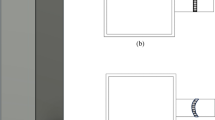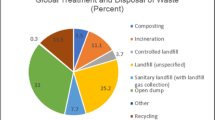Abstract
The leachate drainage volume (LDV) of municipal solid waste (MSW) landfills is crucial to the operation of leachate treatment plant and development at the leachate level, but there is still a lack of reasonable evaluation methods. In this study, the evaluation methods, including both field measurements and numerical simulations, are proposed and applied in the case study of a MSW landfill in Southeastern China. For field measurements, 23 boreholes were drilled to test the leachate level distribution, and thus to determine the saturated volume (SV) of the landfill. The water retention capacity of the drilled samples was tested in a compression cell for a calculation of the undrainage volume (UV) of the landfill, and total LDV was obtained as SV-UV. The total LDV and SV were measured to be 2.31 × 105 m3 and 1.08 × 106 m3, respectively, which indicated a total leachate drainage percentage (LDV/SV) of 22%. For numerical simulations, a hydro-mechanical model is established to predict the daily LDV during layered landfilling. The model couples leachate flow and MSW compression, which are two fundamental processes determining daily LDV. As the model takes into account the leachate generation caused by the compression of MSW, the prediction has a good agreement with the measurement. If ignoring compression, the daily LDV will be underestimated by a percentage of 35%–50%. This study provides basic information and an assessment framework of leachate drainage volume and contributes to leachate management in landfills.







Similar content being viewed by others
Data availability
All data generated or analyzed during this study are included in this published article.
References
Beaven RP (2000) The hydrogeological and geotechnical properties of household waste in relation to sustainable landfilling. Ph.D. thesis, University of London, UK.
Beaven RP, Cox SE, Powrie W (2007) Operation and performance of horizontal wells for leachate control in a waste landfill. J Geotech Geoenviron Eng 133(8):1040–1047
Breitmeyer RJ, Benson CH, Edil TB (2020) Effect of changing unit weight and decomposition on unsaturated hydraulics of municipal solid waste in bioreactor landfills. J Geotech Geoenviron Eng 146(5):04020021
Chen YM, Ke H, Fredlund DG, Zhan LT, Xie Y (2010) Secondary compression of municipal solid wastes and a compression model for predicting settlement of municipal solid waste landfills. J Geotech Geoenviron Eng 136(5):706–717
Cooke AJ (2007) Modelling of clogging in landfill leachate collection systems. Ph.D. thesis, University of Western Ontario, Canada.
Feng SJ, Lu SF, Chen HX, Fu WD, Lü F (2017) Three-dimensional modelling of coupled leachate and gas flow in bioreactor landfills. Comput Geotech 84:138–151
Fleming IR (1999) Biogeochemical processes and clogging of landfill leachate collection systems. Ph.D. thesis, University of Western Ontario, Canada.
Hu J, Ke H, Zhan LT, Chen ZY, Lan JW, Powrie W, Chen YM (2020) Installation and performance of horizontal wells for dewatering at municipal solid waste landfills in China. Waste Manage 103:159–168
Ke H, Hu J, Xu XB, Wang WF, Chen YM, Zhan LT (2017) Evolution of saturated hydraulic conductivity with compression and degradation for municipal solid waste. Waste Manage 65:63–74
Khanbilvardi RM, Ahmed S, Gleason PJ (1995) Flow investigation for landfill leachate (FILL). J Environ Eng 121(1):45–57
Lan JW (2012) Mechanism of leachate generation, transport and mound in MSW landfills and control of leachate level. Ph.D. thesis, Zhejiang University, China.
Lobo A, Tejero I (2007) MODUELO 2: a new version of an integrated simulation model for municipal solid waste landfills. Environ Model Softw 22:59–72
MOHURD (Ministry of Housing and Urban-Rural Development of the Peoples’s Republic of China). (2012) Technical code for geotechnical engineering of municipal solid waste sanitary landfill. CJJ176–2012. China Architecture & Building Press.
National Bureau of Statistics (2020) Annual Report.
Peyton RL, Schroeder PR (1988) Field verification of HELP model for landfills. J Environ Eng 114(2):247–269
Powrie W, Beaven RP (1999) Hydraulic properties of household waste and implications for landfills. Proc Inst Civ Eng Geotech Eng 137(4):235–247
Reddy KR, Hettiarachchi H, Gangathulasi J, Bogner J (2011) Geotechnical properties of municipal solid waste at different phases of biodegradation. Waste Manage 31(11):2275–2286
Reddy KR, Kulkarni HS, Khire MV (2013) Two-phase modeling of leachate recirculation using vertical wells in bioreactor landfills. J Hazard Toxic Radioact Waste 17(4):272–284
Rowe RK, Yu Y (2012) Clogging of finger drain systems in MSW landfills. Waste Manage 32(12):2342–2352
Rowe RK, Yu Y (2013) Modeling of leachate characteristics and clogging of gravel drainage mesocosms permeated with landfill leachate. J Geotech Geoenviron Eng 139(7):1022–1034
São Mateus MDSC, Machado SL, Barbosa MC (2012) An attempt to perform water balance in a Brazilian municipal solid waste landfill. Waste Manage 32(3):471–481
Stoltz G, Tinet AJ, Staub MJ, Oxarango L, Gourc JP (2012) Moisture retention properties of municipal solid waste in relation to compression. J Geotech Geoenviron Eng 138(4):535–543
US EPA (1984) Hydrologic Evaluation Of Landfill Performance (HELP) model. Publication No. EPA/530/SW-84/009.
van Genuchten MT (1980) A closed-form equation for predicting the hydraulic conductivity of unsaturated soils. Soil Sci Soc Am J 44(5):892–898
World Bank (2018) What a Waste 2.0: a global snapshot of solid waste management to 2050. http://datatopics.worldbank.org/what-a-waste/
Xu XB, Zhan TLT, Chen YM, Beaven RP (2014) Intrinsic and relative permeabilities of shredded municipal solid wastes from the Qizishan landfill. China Can Geotech J 51(11):1243–1252
Xu H, Zhan LT, Li H, Lan JW, Chen YM, Zhou HY (2016) Time- and stress-dependent model for predicting moisture retention capacity of high-food-waste-content municipal solid waste: based on experimental evidence. J Zhejiang Univ-Sci A 17(7):525–540
Zhan LT, Xu H, Chen YM, Lan JW, Lin WA, Xu XB, He PJ (2017) Biochemical, hydrological and mechanical behaviors of high food waste content MSW landfill: liquid-gas interactions observed from a large-scale experiment. Waste Manage 68:307–318
Zhang DQ, He PJ, Shao LM, Jin TF, Han JY (2008) Biodrying of municipal solid waste with high water content by combined hydrolytic-aerobic technology. J Environ Sci 20(12):1534–1540
Zornberg JG, Jernigan BL, Sanglerat TR, Cooley BH (1999) Retention of free liquids in landfills undergoing vertical expansion. J Geotech Geoenviron Eng 125(7):583–594
Funding
The work is funded by the Exploration Project of the Natural Science Foundation of Zhejiang Province (Grant nos. LQ21E080003, LCZ19E080001, and LTZ22D010001), the National Natural Science Foundation of China (Grant nos. 52108348 and 51978435), the China Postdoctoral Science Foundation (Grant no. 2021M692836), the Science and Technology Project of the Ministry of Housing and Urban–Rural Development (Grant nos. 2020-K-026 and 2021-K-125), and the Science and Technology Project of Department of Housing and Urban–Rural Development of Zhejiang Province (Grant no. 2020K164).
Author information
Authors and Affiliations
Contributions
HJH performed the field test and wrote the original manuscript. JH established the mathematical model and revised the manuscript. All authors read and approved the final manuscript.
Corresponding author
Ethics declarations
Ethics approval and consent to participate
Not applicable.
Consent for publication
Not applicable.
Competing interests
The authors declare no competing interests.
Additional information
Responsible Editor: Marcus Schulz
Publisher's note
Springer Nature remains neutral with regard to jurisdictional claims in published maps and institutional affiliations.
Rights and permissions
About this article
Cite this article
He, H.J., Hu, J. Leachate drainage volume of municipal solid waste landfills: field testing and hydro-mechanical modeling. Environ Sci Pollut Res 29, 64680–64691 (2022). https://doi.org/10.1007/s11356-022-20413-9
Received:
Accepted:
Published:
Issue Date:
DOI: https://doi.org/10.1007/s11356-022-20413-9




